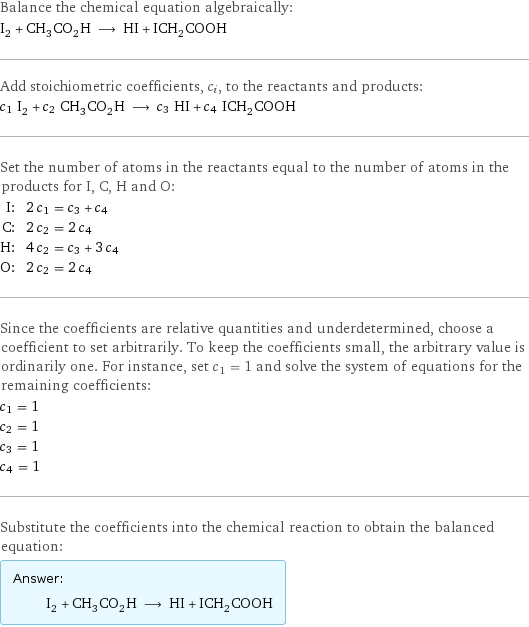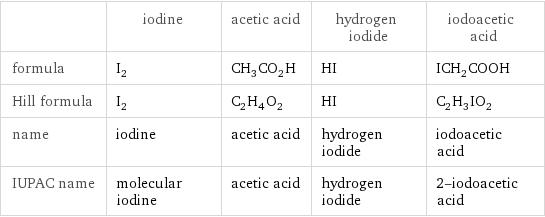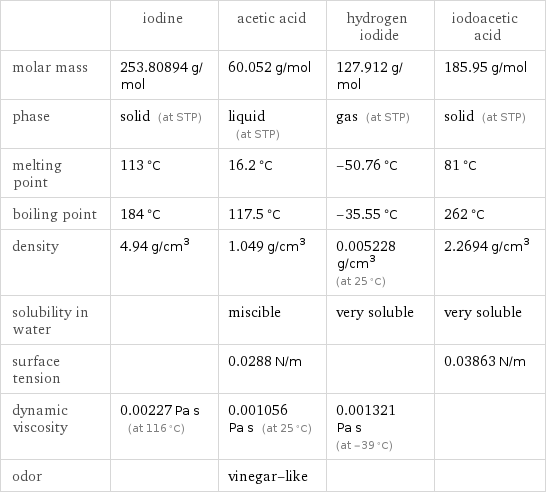Input interpretation

I_2 iodine + CH_3CO_2H acetic acid ⟶ HI hydrogen iodide + ICH_2COOH iodoacetic acid
Balanced equation

Balance the chemical equation algebraically: I_2 + CH_3CO_2H ⟶ HI + ICH_2COOH Add stoichiometric coefficients, c_i, to the reactants and products: c_1 I_2 + c_2 CH_3CO_2H ⟶ c_3 HI + c_4 ICH_2COOH Set the number of atoms in the reactants equal to the number of atoms in the products for I, C, H and O: I: | 2 c_1 = c_3 + c_4 C: | 2 c_2 = 2 c_4 H: | 4 c_2 = c_3 + 3 c_4 O: | 2 c_2 = 2 c_4 Since the coefficients are relative quantities and underdetermined, choose a coefficient to set arbitrarily. To keep the coefficients small, the arbitrary value is ordinarily one. For instance, set c_1 = 1 and solve the system of equations for the remaining coefficients: c_1 = 1 c_2 = 1 c_3 = 1 c_4 = 1 Substitute the coefficients into the chemical reaction to obtain the balanced equation: Answer: | | I_2 + CH_3CO_2H ⟶ HI + ICH_2COOH
Structures

+ ⟶ +
Names

iodine + acetic acid ⟶ hydrogen iodide + iodoacetic acid
Equilibrium constant
![Construct the equilibrium constant, K, expression for: I_2 + CH_3CO_2H ⟶ HI + ICH_2COOH Plan: • Balance the chemical equation. • Determine the stoichiometric numbers. • Assemble the activity expression for each chemical species. • Use the activity expressions to build the equilibrium constant expression. Write the balanced chemical equation: I_2 + CH_3CO_2H ⟶ HI + ICH_2COOH Assign stoichiometric numbers, ν_i, using the stoichiometric coefficients, c_i, from the balanced chemical equation in the following manner: ν_i = -c_i for reactants and ν_i = c_i for products: chemical species | c_i | ν_i I_2 | 1 | -1 CH_3CO_2H | 1 | -1 HI | 1 | 1 ICH_2COOH | 1 | 1 Assemble the activity expressions accounting for the state of matter and ν_i: chemical species | c_i | ν_i | activity expression I_2 | 1 | -1 | ([I2])^(-1) CH_3CO_2H | 1 | -1 | ([CH3CO2H])^(-1) HI | 1 | 1 | [HI] ICH_2COOH | 1 | 1 | [ICH2COOH] The equilibrium constant symbol in the concentration basis is: K_c Mulitply the activity expressions to arrive at the K_c expression: Answer: | | K_c = ([I2])^(-1) ([CH3CO2H])^(-1) [HI] [ICH2COOH] = ([HI] [ICH2COOH])/([I2] [CH3CO2H])](../image_source/2b8b838485c0a718eefa0b0519fb9012.png)
Construct the equilibrium constant, K, expression for: I_2 + CH_3CO_2H ⟶ HI + ICH_2COOH Plan: • Balance the chemical equation. • Determine the stoichiometric numbers. • Assemble the activity expression for each chemical species. • Use the activity expressions to build the equilibrium constant expression. Write the balanced chemical equation: I_2 + CH_3CO_2H ⟶ HI + ICH_2COOH Assign stoichiometric numbers, ν_i, using the stoichiometric coefficients, c_i, from the balanced chemical equation in the following manner: ν_i = -c_i for reactants and ν_i = c_i for products: chemical species | c_i | ν_i I_2 | 1 | -1 CH_3CO_2H | 1 | -1 HI | 1 | 1 ICH_2COOH | 1 | 1 Assemble the activity expressions accounting for the state of matter and ν_i: chemical species | c_i | ν_i | activity expression I_2 | 1 | -1 | ([I2])^(-1) CH_3CO_2H | 1 | -1 | ([CH3CO2H])^(-1) HI | 1 | 1 | [HI] ICH_2COOH | 1 | 1 | [ICH2COOH] The equilibrium constant symbol in the concentration basis is: K_c Mulitply the activity expressions to arrive at the K_c expression: Answer: | | K_c = ([I2])^(-1) ([CH3CO2H])^(-1) [HI] [ICH2COOH] = ([HI] [ICH2COOH])/([I2] [CH3CO2H])
Rate of reaction
![Construct the rate of reaction expression for: I_2 + CH_3CO_2H ⟶ HI + ICH_2COOH Plan: • Balance the chemical equation. • Determine the stoichiometric numbers. • Assemble the rate term for each chemical species. • Write the rate of reaction expression. Write the balanced chemical equation: I_2 + CH_3CO_2H ⟶ HI + ICH_2COOH Assign stoichiometric numbers, ν_i, using the stoichiometric coefficients, c_i, from the balanced chemical equation in the following manner: ν_i = -c_i for reactants and ν_i = c_i for products: chemical species | c_i | ν_i I_2 | 1 | -1 CH_3CO_2H | 1 | -1 HI | 1 | 1 ICH_2COOH | 1 | 1 The rate term for each chemical species, B_i, is 1/ν_i(Δ[B_i])/(Δt) where [B_i] is the amount concentration and t is time: chemical species | c_i | ν_i | rate term I_2 | 1 | -1 | -(Δ[I2])/(Δt) CH_3CO_2H | 1 | -1 | -(Δ[CH3CO2H])/(Δt) HI | 1 | 1 | (Δ[HI])/(Δt) ICH_2COOH | 1 | 1 | (Δ[ICH2COOH])/(Δt) (for infinitesimal rate of change, replace Δ with d) Set the rate terms equal to each other to arrive at the rate expression: Answer: | | rate = -(Δ[I2])/(Δt) = -(Δ[CH3CO2H])/(Δt) = (Δ[HI])/(Δt) = (Δ[ICH2COOH])/(Δt) (assuming constant volume and no accumulation of intermediates or side products)](../image_source/5c8e0f97cc67a4364e7fd5eea48d242d.png)
Construct the rate of reaction expression for: I_2 + CH_3CO_2H ⟶ HI + ICH_2COOH Plan: • Balance the chemical equation. • Determine the stoichiometric numbers. • Assemble the rate term for each chemical species. • Write the rate of reaction expression. Write the balanced chemical equation: I_2 + CH_3CO_2H ⟶ HI + ICH_2COOH Assign stoichiometric numbers, ν_i, using the stoichiometric coefficients, c_i, from the balanced chemical equation in the following manner: ν_i = -c_i for reactants and ν_i = c_i for products: chemical species | c_i | ν_i I_2 | 1 | -1 CH_3CO_2H | 1 | -1 HI | 1 | 1 ICH_2COOH | 1 | 1 The rate term for each chemical species, B_i, is 1/ν_i(Δ[B_i])/(Δt) where [B_i] is the amount concentration and t is time: chemical species | c_i | ν_i | rate term I_2 | 1 | -1 | -(Δ[I2])/(Δt) CH_3CO_2H | 1 | -1 | -(Δ[CH3CO2H])/(Δt) HI | 1 | 1 | (Δ[HI])/(Δt) ICH_2COOH | 1 | 1 | (Δ[ICH2COOH])/(Δt) (for infinitesimal rate of change, replace Δ with d) Set the rate terms equal to each other to arrive at the rate expression: Answer: | | rate = -(Δ[I2])/(Δt) = -(Δ[CH3CO2H])/(Δt) = (Δ[HI])/(Δt) = (Δ[ICH2COOH])/(Δt) (assuming constant volume and no accumulation of intermediates or side products)
Chemical names and formulas

| iodine | acetic acid | hydrogen iodide | iodoacetic acid formula | I_2 | CH_3CO_2H | HI | ICH_2COOH Hill formula | I_2 | C_2H_4O_2 | HI | C_2H_3IO_2 name | iodine | acetic acid | hydrogen iodide | iodoacetic acid IUPAC name | molecular iodine | acetic acid | hydrogen iodide | 2-iodoacetic acid
Substance properties

| iodine | acetic acid | hydrogen iodide | iodoacetic acid molar mass | 253.80894 g/mol | 60.052 g/mol | 127.912 g/mol | 185.95 g/mol phase | solid (at STP) | liquid (at STP) | gas (at STP) | solid (at STP) melting point | 113 °C | 16.2 °C | -50.76 °C | 81 °C boiling point | 184 °C | 117.5 °C | -35.55 °C | 262 °C density | 4.94 g/cm^3 | 1.049 g/cm^3 | 0.005228 g/cm^3 (at 25 °C) | 2.2694 g/cm^3 solubility in water | | miscible | very soluble | very soluble surface tension | | 0.0288 N/m | | 0.03863 N/m dynamic viscosity | 0.00227 Pa s (at 116 °C) | 0.001056 Pa s (at 25 °C) | 0.001321 Pa s (at -39 °C) | odor | | vinegar-like | |
Units
